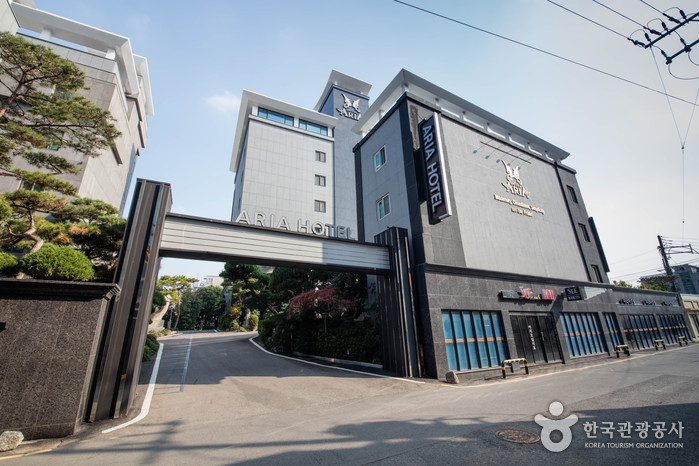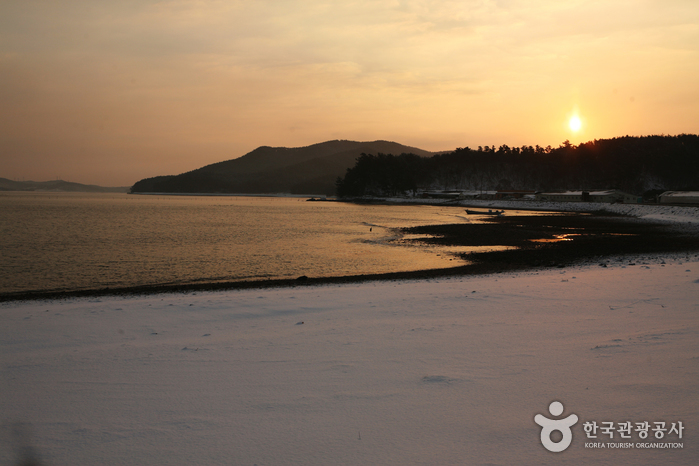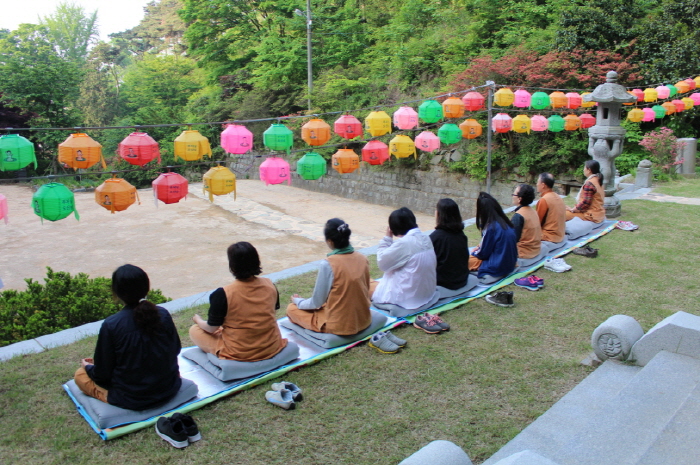Seosan Buseoksa Temple (부석사(서산))
.0M 2024-12-03
243 Buseoksa-gil, Seosan-si, Chungcheongnam-do
+82-41-662-3824
Located on Dobisan Mountain in Seosan, Chungcheongnam-do, Buseoksa Temple was built by the Great Monk Uisang in 677, the 17th year of King Munmu of Silla, and was later rebuilt by Great Monk Muhak during the Joseon dynasty. The temple houses eight seated Buddha statues and attracts many visitors due to its magnificent surrounding scenery.
Lotte Himart - Seosan Lotte Mart Branch [Tax Refund Shop] (롯데하이마트 서산롯데마트점)
8.1Km 2024-04-19
27, Chungui-ro, Seosan-si, Chungcheongnam-do
-
Lotte Mart - Seosan Branch [Tax Refund Shop] (롯데마트 서산점 [사후면세점])
8.1Km 2024-04-22
6 lots, 27, Chungui-ro, Seosan-si, Chungcheongnam-do
-
Seosan Hotel Aria (서산아리아호텔)
9.0Km 2024-12-23
94 , Dongheon-ro, Seosan-si, Chungcheongnam-do
+82-41-668-7822
Seosan Aria Hotel, near Central Lake Park in Seosan-si, Chungcheonnam-do, consists of a main building, new building, an annexe, and a deluxe building, and has 80 rooms accommodating up to 160 people. There are three types of room: Garden rooms have access to the roof-top garden; Studio rooms are equipped with home theatres and accomodate up to four people; and Duplex rooms. Public transport connections are good, and the hotel is just 1km away from Seosan City Hall and adjacent shopping malls. There’s a large parking lot (one car per room).
Seosan Kkotgejang (서산꽃게장)
9.2Km 2024-03-04
92 Hanmaeum 5-ro, Seosan-si, Chungcheongnam-do
041-665-8829
Seosan Kkotgejang specializes in preparing blue crabs harvested from the Seohae Coast using traditional methods. They offer both ganjang kkotgejang (soy sauce marinated blue crab) and yangnyeom kkotgejang (spicy marinated blue crab). The ganjang kkotgejang is prepared by marinating fresh crabs with ginger, garlic, soy sauce, and other seasonings, resulting in a savory and flavorful taste. The yangnyeom kkotgejang is marinated with a seasoning mixture primarily consisting of chili pepper powder. They also serve dishes like ureok jeotguk (salted rockfish soup) and yeongyang gulbap (nutritious oyster rice). Seosan is known for its bay, providing an ideal habitat for blue crabs.
CU - Seosaneupnae Village Branch [Tax Refund Shop] (cu서산읍내빌리지점)
9.4Km 2024-06-27
36, Yangyujeong 1-ro, Seosan-si, Chungcheongnam-do
-
Cheonsuman Bay - Migratory Bird Sanctuary (천수만(철새도래지))
9.6Km 2021-05-21
Buseok-myeon & Gobuk-myeon, Seosan-si, Chungcheongnam-do
+82-41-661-8054
Cheonsuman Bay emerged as a habitat for migratory birds as a result of a reclamation project that was undertaken in 1984. A breakwater was built around this area, which created Ganwolho Lake and Bunamho Lake. Moreover, a vast agricultural land spanning 6,400 hectares was formed on what used to be a mud flat. The monthly average temperature of Cheonsuman Bay area between October and March is about 1.2 degree Celsius higher than inland areas at the same latitude because of its oceanic climate. Such geographical conditions have made Cheonsuman Bay an ideal wintering site for migratory birds.
Cheonsuman Bay is located midway along the migration route of birds migrating from northern Siberia or Manchuria to Southeast Asia. As a result, Cheonsuman Bay has become home to nearly 200 different species of migratory birds that can be watched all year round. In winter, the area becomes a wintering site for over 300 thousand ducks and wild geese, as well as a wide variety of endangered species like storks, spoonbills, mute swans, and white-naped cranes. Lucky birdwatchers might be able to witness the great spectacle created by tens of thousands of migratory birds flying in a flock over the Cheonsuman Bay area.
Samgi Kkotgejang (삼기꽃게장)
9.6Km 2024-03-04
162 Goun-ro, Seosan-si, Chungcheongnam-do
041-665-5392
Samgi Kkotgejang is a gejang (marinated crab) specialty restaurant with over 40 years of experience in cooking blue crabs harvested from the Seohae Coast using traditional methods. Their ganjang kkotgejang (soy sauce marinated crab) is prepared by marinating crabs in sauce seasoned with salted oyster extract for a year and then further seasoned with garlic, ginger, and other spices, resulting in a rich and savory flavor. They also offer dishes like kkotgetang (spicy blue crab stew) and yangnyeom gejang (spicy marinated crab), and eoriguljeot (salted oysters) are served as a side dish. Seosan is known for its bay, providing an ideal habitat for blue crabs.
Jeonggane Baksok Nakjitang (정가네박속낙지탕)
9.8Km 2024-02-26
6, Sudeung-gil, Taean-eup, Taean-gun, Chungcheongnam-do
Jeonggane Baksok Nakjitang is a restaurant specializing in baksok nakjitang (gourd and octopus soup, steamed rice not included) and haemul kalguksku (noodle soup with seafood). Baksok nakjitang (gourd and octopus soup) is a folk dish of Taean, a soup made with octopus sourced from Taean’s tidal flats and calabash. This restaurant uses only the freshest octopus caught from Taean’s tidal flats, so the octopus remains chewy and tender even after boiling. Noodles can be added to the soup. Taean’s proximity to the sea and its extensive tidal flats make seafood from Taean plentiful and delicious.
Seosan Seogwangsa Temple (서광사(서산))
10.2Km 2021-09-10
44, Buchunsan 1-ro, Seosan-si, Chungcheongnam-do
+82-41-664-2002
Seongwangsa Temple is located in the quiet downtown area of Eupnae-dong, Seosan in Chungcheongnam-do. Its convenient location makes it easily accessible from almost anywhere in town.
The temple was built by Great Monk Daegyeong in 928 in the late Silla period and the scholar Choi Chiwon came here to study while he was serving as the governor of Buseong-gun (currently Seosan) in 893. Originally, the temple was called Samseonam, or Three Hermitages, for there had been three hermitages in the upper, middle, and lower part of Buchunsan Mountain. During the late Joseon dynasty, the hermitages in the upper and middle part were closed and only the one at the bottom survived. In 1987, the name was changed to Seogwangsa Temple.

![Lotte Himart - Seosan Lotte Mart Branch [Tax Refund Shop] (롯데하이마트 서산롯데마트점)](http://tong.visitkorea.or.kr/cms/resource/29/2883329_image2_1.jpg)
![Lotte Mart - Seosan Branch [Tax Refund Shop] (롯데마트 서산점 [사후면세점])](http://tong.visitkorea.or.kr/cms/resource/26/2883326_image2_1.jpg)



 English
English
 한국어
한국어 日本語
日本語 中文(简体)
中文(简体) Deutsch
Deutsch Français
Français Español
Español Русский
Русский